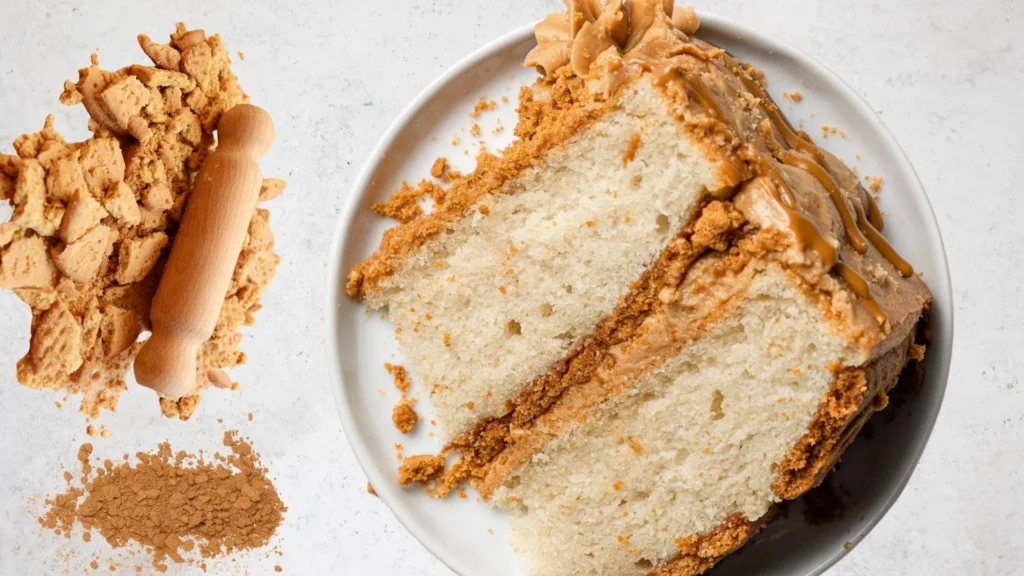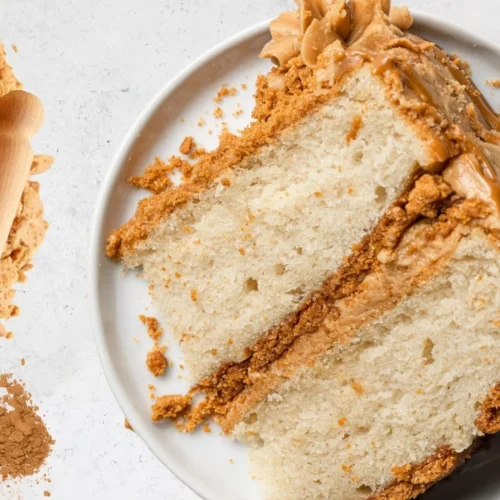Butter cookie cake recipe is a soft, rich, and sweet cake made using crushed butter cookies mixed into a buttery batter. I first watched it being made in an online baking video and felt inspired to try it on a quiet weekend.
My experience in baking helped me adjust a few steps, and over time I’ve made this recipe more than six times. I sometimes follow the bakery method, but often add my own twist, like using cookie butter in the frosting.
I’ve shared butter cookie cake recipe with friends and family who always enjoy it. Now I will explain how to make butter cookie cake recipe.
Why We Love This Recipe
This butter cookie cake recipe stands out because of its rich, buttery flavor combined with a delicate, soft texture that feels indulgent but never overwhelming.
The crushed cookies mixed into the batter add a unique crunch and depth, giving the cake a memorable twist. The frosting complements the cake perfectly with its smooth, creamy consistency and subtle spice from the cookie butter.
It reminds many of familiar, comforting tastes but in a fresh way. The balance of sweetness and richness makes it a favorite for gatherings and quiet moments alike.
How To Prepare Butter Cookie Cake Recipe?
To make this butter cookie cake recipe just right, I’ll guide you through every step clearly and simply. I’ll share helpful tips and the kitchen tools I use, though you won’t need them all to succeed.
Use what you have on hand, and you’ll still bake a butter cookie cake recipe wonderfully rich, flavorful cake that’s sure to impress and satisfy.
Recipe Overview
Preparation Time: 20 minutes
Cooking Time: 40 minutes
Total Time: Approximately 1 hour
Course: Dessert
Cuisine: Fusion / American-European
Yield: about 12 people
Kitchen Utensils
- Mixing bowls
- Electric hand or stand mixer
- Rubber spatula
- Measuring cups and spoons
- 8-inch round cake pans (2)
- Parchment paper
- Cooling rack
- Food processor or zip-top bag (for crushing cookies)
- Offset spatula (for frosting)
- Serrated knife (if leveling cake layers)
Ingredients
For the Cake:
- 1 cup (2 sticks) unsalted butter, softened
- 1 cup granulated sugar
- 3 large eggs, at room temperature
- 1½ cups all-purpose flour
- ½ teaspoon baking powder
- ¼ teaspoon salt
- 1 teaspoon vanilla extract
- ½ cup whole milk
- ½ cup crushed butter cookies (like Biscoff, speculoos, or shortbread)
For the Biscoff Buttercream:
- 15 plain Biscoff cookies
- 1½ cups (3 sticks) unsalted butter, softened
- 2¾ cups powdered sugar
- 1½ teaspoons vanilla extract
- ¼ teaspoon salt
- 1½ tablespoons milk or heavy cream
- ¼ cup smooth Biscoff spread (cookie butter)

Instructions
1. Preheat & Prep Pans
Begin by preheating your oven to 350°F (175°C). Grease two 8-inch round cake pans and line the bottoms with parchment paper for easy removal. Lightly dust the sides with flour or use baking spray.
2. Make the Cake Batter
In a large bowl, cream together the softened butter and granulated sugar using an electric mixer until light and fluffy (about 3–4 minutes). Add eggs one at a time, beating well after each addition. Stir in the vanilla extract.
3. Mix the Dry Ingredients
In a separate bowl, sift together the flour, baking powder, and salt. Gradually add the dry mixture to the wet ingredients, mixing on low speed. Pour in the milk slowly and continue mixing until just combined. Fold in the crushed butter cookies using a spatula.
4. Bake the Cake
Divide the batter evenly between the prepared pans. Smooth the tops and bake for 35–40 minutes, or until a toothpick inserted into the center comes out clean. Remove from oven and let cool in pans for 10–15 minutes, then transfer to a wire rack to cool completely.
5. Prepare the Biscoff Buttercream
While the cakes cool, crush the Biscoff cookies in a food processor until fine crumbs form. In a large bowl, beat the butter until pale and creamy (about 2–3 minutes). Gradually add the powdered sugar, mixing on low at first, then increasing speed. Stir in vanilla, salt, Biscoff spread, and milk (or cream) and beat until smooth. Fold in the crushed cookies for texture.
6. Assemble the Cake
If the cake layers are domed, use a serrated knife to level them. Place one layer on a serving plate or cake stand. Spread a generous amount of buttercream on top. Add the second layer and frost the top and sides of the cake with the remaining buttercream. Smooth it out with an offset spatula.
7. Decorate and Serve
If desired, top with extra cookie crumbs, whole Biscoff cookies, or a drizzle of warmed cookie butter. Chill for 15–20 minutes before slicing for cleaner cuts. Serve at room temperature for the best flavor.
Nutrition Facts Of Butter Cookie Cake Recipe
| Nutrition | Amounts |
|---|---|
| Calories | 510 |
| Fat | 32g |
| Saturated Fat | 20g |
| Carbohydrates | 52g |
| Sugar | 34g |
| Protein | 4g |
| Fiber | 1g |
| Sodium | 180mg |
Why My Recipe Works
My butter cookie cake recipe works because it balances moisture, texture, and flavor in just the right way. The combination of softened butter and sugar creates a rich, tender crumb.
Using crushed butter cookies inside the batter adds a deep, toasted cookie flavor and a slight crunch without drying out the cake. The milk keeps it moist, and the eggs bind everything smoothly.
The frosting, made with real cookie butter and crushed Biscoff, brings extra flavor and creamy texture. Every step is tested for consistency and taste, which makes this recipe reliable and satisfying every time.
Amazing Serving Ideas For Butter Cookie Cake Recipe
Serve a slice topped with a scoop of vanilla ice cream for a delightful contrast between warm cake and cold cream. Drizzle warm caramel or chocolate sauce over each piece for extra indulgence.
Add a sprinkle of crushed cookies or toasted nuts on top to give it a crunchy finish. Pair the cake with fresh fruit like strawberries or raspberries to brighten the flavors.
For gatherings, cut the butter cookie cake recipe into small squares and serve on a platter with coffee or tea. These ideas make the cake even more enjoyable and inviting.
Health Benefits Of Butter Cookie Cake Recipe
Butter cookie cake recipe is a treat that offers some benefits despite being a dessert. The eggs provide protein and essential vitamins like B12.
Butter contains fat-soluble vitamins A, D, and E, which support overall health in moderation. The cookies add a bit of fiber from the wheat flour, especially if made with whole grains. Milk contributes calcium and vitamin D for bone strength.
While it’s a rich dessert best enjoyed occasionally, the combination of these ingredients can offer small nutritional value alongside the delicious flavors. Balancing portion size is key to enjoying it healthily.
Additions For Make More Delicious
1. Chopped Toasted Walnuts or Pecans: Adding toasted nuts gives the cake a satisfying crunch and a rich, nutty flavor that complements the buttery sweetness. Toasting intensifies their aroma and adds depth.
2. Mini Chocolate Chips: Folding mini chocolate chips into the batter creates little bursts of melty chocolate in every bite, balancing the cookie flavor with creamy sweetness.
3. Dried Cranberries or Raisins: These add chewy texture and a natural sweetness, introducing subtle fruity notes that contrast nicely with the richness of the cake.
4. Shredded Coconut: Incorporating shredded coconut adds both texture and a tropical hint, making the cake feel lighter and more interesting. Toasting the coconut before adding can enhance its flavor.
5. Instant Coffee Powder: A small amount of coffee powder mixed into the batter brings a subtle mocha undertone, enhancing the butter and cookie flavors without overpowering the cake.
Variations Of Butter Cookie Cake Recipe
➤ Ginger Snap Cookies Instead of Butter Cookies: Swapping the crushed butter cookies for ginger snaps changes the flavor profile to a spiced, slightly zesty cake, perfect for fall or winter treats.
➤ Brown Sugar in Place of Granulated Sugar: Using brown sugar adds moisture and a deep caramel richness to the cake, making it taste more complex and tender.
➤ Buttermilk Instead of Whole Milk: Buttermilk’s tanginess tenderizes the crumb and adds a slight acidity, giving the cake a subtle, fresh flavor and moist texture.
➤ Cream Cheese in the Frosting: Adding cream cheese to the buttercream frosting introduces a pleasant tanginess and smooth creaminess, cutting through the sweetness and making the frosting lighter and more balanced.
➤ Cocoa Powder in the Batter: Mixing cocoa powder into the cake batter creates a chocolate version of the Butter Cookie Cake, combining rich chocolate flavor with the familiar buttery cookie crunch for a decadent twist.
Can I Use Different Types Of Cookies In The Cake?
Absolutely. While classic Biscoff or speculoos cookies are popular, you can experiment with other buttery cookies like shortbread or even graham crackers.
Each type changes the flavor slightly speculoos adds warm spice notes, while shortbread gives a richer, buttery taste. Just make sure to crush them finely so they mix evenly into the batter.
Is It Necessary To Use Room Temperature Eggs And Butter?
Yes, using room temperature eggs and butter is important because they combine more easily and evenly into the batter. Cold butter can cause lumps, and cold eggs don’t emulsify well, leading to a denser cake.
Letting these ingredients come to room temperature helps create a smooth batter and a tender, fluffy texture in the finished cake.
Can I Make This Cake Gluten-Free?
You can substitute all-purpose flour with a gluten-free flour blend, preferably one made for baking that contains xanthan gum or another binder.
Keep in mind the texture may be slightly different sometimes gluten-free cakes are a bit more crumbly or less airy. It’s a good idea to test the recipe once and adjust liquid or baking time if needed.
How Should I Crush The Cookies For The Batter?
The easiest way is to use a food processor to quickly turn cookies into fine crumbs. If you don’t have one, place the cookies in a sturdy zip-top bag and gently crush them with a rolling pin or the bottom of a heavy glass. Avoid crushing them too coarsely or unevenly, as large chunks can cause uneven texture in the cake.
Can This Cake Be Made Into Cupcakes?
Yes, the batter works well for cupcakes too. Simply line a muffin tin with cupcake liners and fill each about two-thirds full.
Bake at 350°F (175°C) for 18 to 22 minutes, checking doneness with a toothpick. This is great for smaller servings or parties, and the frosting can be piped on for a pretty presentation.
How To Store Leftovers
To store leftover butter cookie cake recipe, first make sure it has completely cooled and the frosting is set. Wrap the cake tightly in plastic wrap or place it in an airtight container to keep it fresh.
Store at room temperature if you plan to eat it within two days. For longer storage, keep butter cookie cake recipe in the refrigerator for up to four days.
Before serving refrigerated cake, let it come to room temperature for about 30 minutes so the texture and flavor are at their best. You can also freeze the cake, wrapped well, for up to two months.
Conclusion
This was one of my easy and delicious ideas butter cookie cake recipe to make and truly enjoyed every bite. The rich, buttery flavor and soft texture made it special each time I baked it.
Now butter cookie cake recipe your turn to try it out follow the steps, enjoy the process, and make it your own if you like.
After you make butter cookie cake recipe, don’t forget to tell me how much you enjoyed it and how delicious it turned out. I know you’ll love it just as much as I do.
You Might Also Like
Traditional Breton Butter Cake Recipe
Copycat Mastro’s Butter Cake Recipe Bakery-Style
Reeses Peanut Butter Cake Recipe | Best Delicious
Apple Butter Cake Recipe [Best Comfortable]
Old-Fashioned Butter Pecan Pound Cake Recipe

Butter Cookie Cake Recipe
Equipment
- Mixing bowls
- Electric hand or stand mixer
- Rubber spatula
- Measuring cups and spoons
- 8-inch round cake pans (2)
- Parchment paper
- Cooling rack
- Food processor or zip-top bag (for crushing cookies)
- Offset spatula (for frosting)
- Serrated knife (if leveling cake layers)
Ingredients
For the Cake:
- 1 cup 2 sticks unsalted butter, softened
- 1 cup granulated sugar
- 3 large eggs at room temperature
- 1½ cups all-purpose flour
- ½ teaspoon baking powder
- ¼ teaspoon salt
- 1 teaspoon vanilla extract
- ½ cup whole milk
- ½ cup crushed butter cookies like Biscoff, speculoos, or shortbread
For the Biscoff Buttercream:
- 15 plain Biscoff cookies
- 1½ cups 3 sticks unsalted butter, softened
- 2¾ cups powdered sugar
- 1½ teaspoons vanilla extract
- ¼ teaspoon salt
- 1½ tablespoons milk or heavy cream
- ¼ cup smooth Biscoff spread cookie butter
Instructions
Preheat & Prep Pans
- Begin by preheating your oven to 350°F (175°C). Grease two 8-inch round cake pans and line the bottoms with parchment paper for easy removal. Lightly dust the sides with flour or use baking spray.
Make the Cake Batter
- In a large bowl, cream together the softened butter and granulated sugar using an electric mixer until light and fluffy (about 3–4 minutes). Add eggs one at a time, beating well after each addition. Stir in the vanilla extract.
Mix the Dry Ingredients
- In a separate bowl, sift together the flour, baking powder, and salt. Gradually add the dry mixture to the wet ingredients, mixing on low speed. Pour in the milk slowly and continue mixing until just combined. Fold in the crushed butter cookies using a spatula.
Bake the Cake
- Divide the batter evenly between the prepared pans. Smooth the tops and bake for 35–40 minutes, or until a toothpick inserted into the center comes out clean. Remove from oven and let cool in pans for 10–15 minutes, then transfer to a wire rack to cool completely.
Prepare the Biscoff Buttercream
- While the cakes cool, crush the Biscoff cookies in a food processor until fine crumbs form. In a large bowl, beat the butter until pale and creamy (about 2–3 minutes). Gradually add the powdered sugar, mixing on low at first, then increasing speed. Stir in vanilla, salt, Biscoff spread, and milk (or cream) and beat until smooth. Fold in the crushed cookies for texture.
Assemble the Cake
- If the cake layers are domed, use a serrated knife to level them. Place one layer on a serving plate or cake stand. Spread a generous amount of buttercream on top. Add the second layer and frost the top and sides of the cake with the remaining buttercream. Smooth it out with an offset spatula.
Decorate and Serve
- If desired, top with extra cookie crumbs, whole Biscoff cookies, or a drizzle of warmed cookie butter. Chill for 15–20 minutes before slicing for cleaner cuts. Serve at room temperature for the best flavor.

Hi! I’m Sophia, your trusted cake guide with years of hands-on baking experience. I’m passionate about creating delicious and wholesome cakes that bring happiness to every occasion and home. Whether you’re a beginner or seasoned baker, I’m here to share tips, recipes, and inspiration to make your baking journey enjoyable and rewarding. From classic flavors to healthy twists, my goal is to help you discover the joy of baking and sharing beautiful cakes with family and friends.